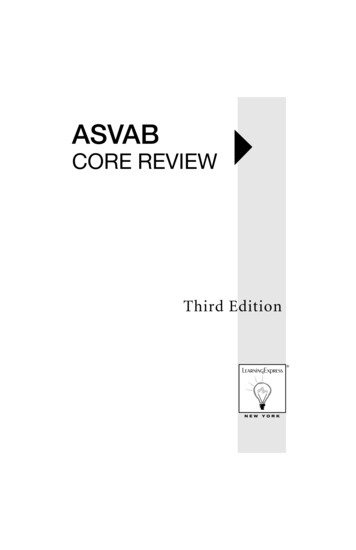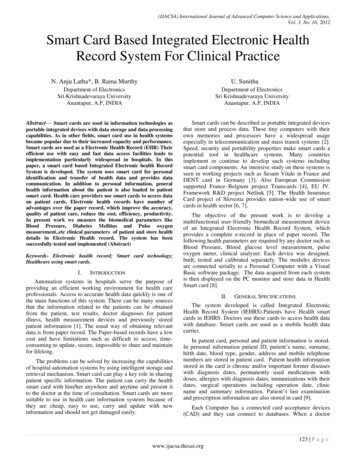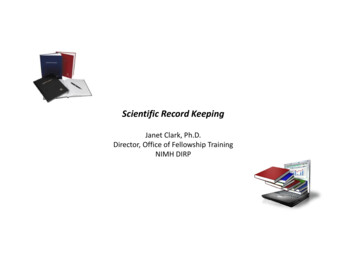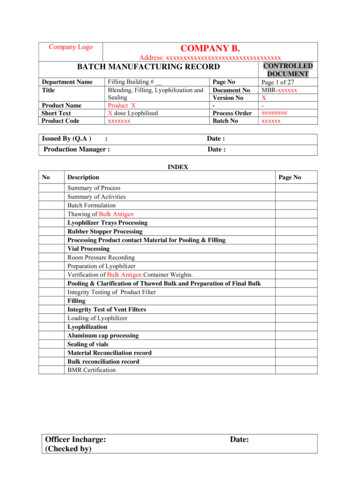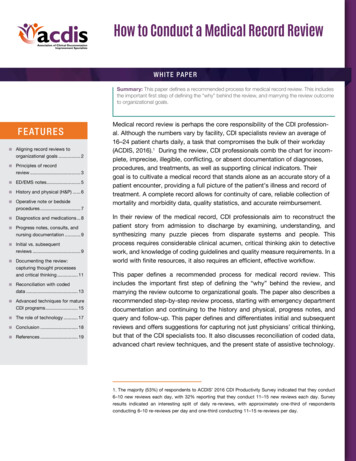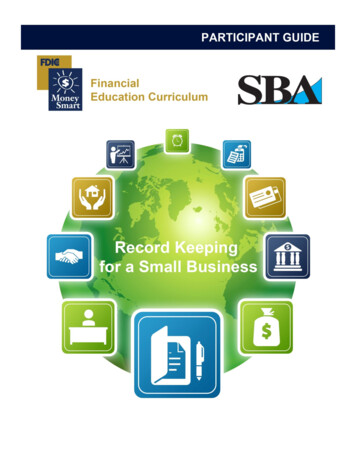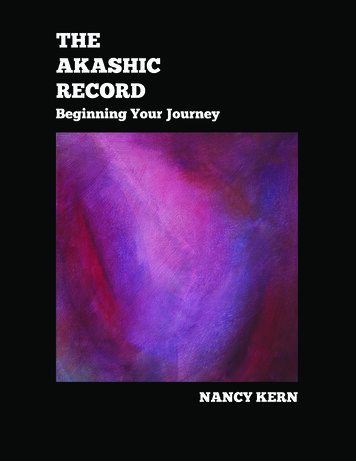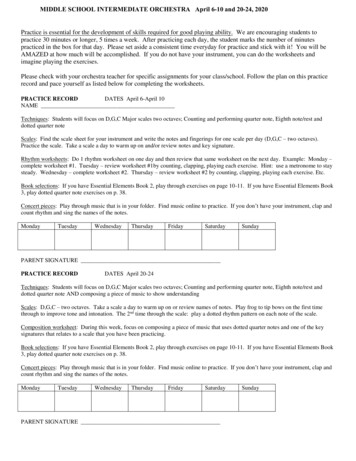
Transcription
MIDDLE SCHOOL INTERMEDIATE ORCHESTRA April 6-10 and 20-24, 2020Practice is essential for the development of skills required for good playing ability. We are encouraging students topractice 30 minutes or longer, 5 times a week. After practicing each day, the student marks the number of minutespracticed in the box for that day. Please set aside a consistent time everyday for practice and stick with it! You will beAMAZED at how much will be accomplished. If you do not have your instrument, you can do the worksheets andimagine playing the exercises.Please check with your orchestra teacher for specific assignments for your class/school. Follow the plan on this practicerecord and pace yourself as listed below for completing the worksheets.PRACTICE RECORDDATES April 6-April 10NAMETechniques: Students will focus on D,G,C Major scales two octaves; Counting and performing quarter note, Eighth note/rest anddotted quarter noteScales: Find the scale sheet for your instrument and write the notes and fingerings for one scale per day (D,G,C – two octaves).Practice the scale. Take a scale a day to warm up on and/or review notes and key signature.Rhythm worksheets: Do 1 rhythm worksheet on one day and then review that same worksheet on the next day. Example: Monday –complete worksheet #1. Tuesday – review worksheet #1by counting, clapping, playing each exercise. Hint: use a metronome to staysteady. Wednesday – complete worksheet #2. Thursday – review worksheet #2 by counting, clapping, playing each exercise. Etc.Book selections: If you have Essential Elements Book 2, play through exercises on page 10-11. If you have Essential Elements Book3, play dotted quarter note exercises on p. 38.Concert pieces: Play through music that is in your folder. Find music online to practice. If you don’t have your instrument, clap andcount rhythm and sing the names of the SundayPARENT SIGNATUREPRACTICE RECORDDATES April 20-24Techniques: Students will focus on D,G,C Major scales two octaves; Counting and performing quarter note, Eighth note/rest anddotted quarter note AND composing a piece of music to show understandingScales: D,G,C – two octaves. Take a scale a day to warm up on or review names of notes. Play frog to tip bows on the first timethrough to improve tone and intonation. The 2nd time through the scale: play a dotted rhythm pattern on each note of the scale.Composition worksheet: During this week, focus on composing a piece of music that uses dotted quarter notes and one of the keysignatures that relates to a scale that you have been practicing.Book selections: If you have Essential Elements Book 2, play through exercises on page 10-11. If you have Essential Elements Book3, play dotted quarter note exercises on p. 38.Concert pieces: Play through music that is in your folder. Find music online to practice. If you don’t have your instrument, clap andcount rhythm and sing the names of the PARENT SIGNATURESunday
#1 Eighth NotesAn eighth note looks like a quarter note with a flag. If two or more eight notes appear in a row, theeighth notes are connected with a beam.quarter noteJeighth noterrrJ J J v-flag1flait,.,"i - beamAn eighth note has a value of half of a beat. When writing the counts, use a plus sign( ) for eighth notes.1count: one 2and two 34and three and four and1. Clap the rhythm of the notes while counting the beats out loud.t J J J J J J I n J J Jl I J Jl J Jl I Jm J1 2 341 234 12 34 1 2 3II42. Write in the beats below the notes indicated. Then clap the rhythm while counting the beats out loud.I J J J J I E! r .fJ I J.II!3. Write a time signature after the clef sign. Write in the beats below the notes indicated.Then clap the rhythm while counting the beats out loud.jIICJIE/CJr IEJEJ'E!lr-----------4. Write in the count '1elow the notes and then add the missing barlines.41 J--§PUS ':11111 1:t Stlil!Hl-,. --J J J J J ] J. J,.--- - --- - IIII----s music is intended for educational and personal use only. Any distribution outside these means is prohibited.Copyright Theresa Chen I www.OpusMusicWorlcsbeets.com
#2 : Eighth Rests[] An eighth rest is shown as follows. After the first eighth rest, practice drawing 5 more eighth rests.An eighth rest has a value of half of a beat. When writing the counts, use a plus sign ( ) for eighth notes andeighth rests.1spoken: one 2and two and3three 4and four1. Clap the rhythm of the notes while counting the beats out loud.1 2 3 4 1 23 4 1 2 3 4 2 342. Write in the counts below the notes indicated. Then clap the rhythm while counting the beats out loud.3. Write the count below the notes. Then clap the rhythm while counting the beats out loud.:,: I F cJ I F , p I Cf Q , I CJ E r I O , ., p I O ., F II4. Write in the count below the notes. Then add the missing barlines.' Jlfj J J J5. Draw the missing flags and beams on the eighth notes that are missing flags or beams.This music is intended for educational and personal use only. Any distribution outside these means is prohibited.Copyright Theresa Chen I www.OpusMusicWorlcsheets.com
#3 : Dotted Quarter NotesA dot written after a note adds one-half of the note's value to the original notfs value.J I½ beat ( ). )A quarter note equals one beat. ½beat ( })A dot after the quarter note adds ½beat(½of the original value).A dotted quarter note equals 1 ½ beats.J. 1 ½ beats ( )))I)Hence, the rhythmic value of a dotted quarter note is one and one half beats and it is equivalent to aquarter note tied to an eighth note. Count the rhythm by sub-dividing to the half beats.l 2 3 4) 1. Clap the rhythm of the notes while counting the beats out loud.1 2 3 4 1 2 3 4 l 2 3 4 1 2 3 4 II2. Write the count below the notes indicated. Then clap the rhythm while counting the beats out loud.l J.IJ., ) In ., J. II3. Write the count below the notes indicated. Then clap the rhythm while counting the beats out loud.4. Some dotted quarter notes are missing dots behind the quarter note. Add the missing dots.II5. The barlines are missing from the following example. Add the missing barlines.This music is intended for educational and personal use only. Any distribution outside these means is prohibited.Copyright Theresa Chen I www.OpusMusicWorksheets.comp II
#4- Music MathAbout This ActivityDrill three basic rhythmic values with this musical math fact worksheet. Provide the answers for thefirst column of "facts" (Example: 2). Then try to beat your score with more correct answers, orby racing the clock to complete the second and third columns in record time. This activity is greatfun for the music classroom, as kids work together in pairs racing to be the first to complete theworksheet!Worksheet Four/Dotted Quarter, Quarter, and Eighth NotesIt All Adds Up! J ) J n J. )J. J.) )n ; J J. ) ) JJ JJ .J J -Score: --- of 10) ) -J. J.J. n ; -J J.J ) ) n n ) J. Score: --- of 10J ) J nJ. ) n ) -) ) -J. J. .J J J J -n n ) ) Score: --- of 10n J .J. J ; .J. n JBonus Question:; .J. J. ) J n-www. makingmusicfun. net
Violin: https://www.youtube.com/playlist?list PLAV5iQD3rm7RHEO h8BdXSui5JUxoDqCDScales- You will write the letter names below the ascending 2 octave scale.- Then you will draw the notes for the descending part of the scale.- You will write finger numbers above every note.rrrtT t t ilf J J J J J r r E r ---------------Xi .tatf & EL k L X1 rrrrJJJJJJJ1Jt [ill kwJ ·., :!: 1k f k L XJr r r r r rftrJt ---------------x1JJ J 1 L L L
Viola: https://www.youtube.com/playlist?list PLAV5iQD3rm7QRo4nzo2PR7TW9VMpPKqtT
Cello: https://www.youtube.com/playlist?list PLAV5iQD3rm7QPjIhEhRhgU5BD7sp8wH7ZBass: https://www.youtube.com/playlist?list PLAV5iQD3rm7SUnrjAPS2cjVOPU3-nU4OwCt,\\ o/ c,, - You will write lhe .!:! the asoemling 2 octave soa/e.- Then you will draw the notes for the descending part of the scale.- You will write in finger numbers above all notes ---------------Xi *iii t L X --------------1::w l t - - - -- -- --- --- -- .::I.!- f k L t 3s§ E§ ! § § ?-§ ! Ei f ( ] )(1------ --------------- - - L L z
Fourth Quarter Composition Project – Dotted Quarter NotesOBJECTIVE: to show understanding of dotted quarter notes and key signatures.Students will compose a piece of music that is at least 8 measures long that uses specific rhythm patterns and keysignatures. Compositions can be longer than 8 measures and can use repeat signs, first and 2nd endings, D.C. al coda,etc Rhythm patterns: Students must show proper use of dotted quarter note followed by an eighth note at least twicewithin the piece. Students may also use whole notes and rests, half notes and rests, quarter notes and rests; eighthnotes and rests.Key Signatures: Students may use the following key signatures and must be displayed at the beginning of every line: C,G, D. Check book or online sources to notate the key signature correctly.Time Signature: Students may use the following time signatures: 2/4; ¾; or 4/4. As you compose, make sure that youhave the correct number of beats in each measure based on the time signature that you choose.Follow the steps for setting up your composition:1) Use staff paper for your composition or an online music writing program such as “Noteflight” or “FinaleNotepad”2) Use a pencil so that you can edit your work.3) Draw your clef sign on every line that you are using for your composition4) Choose and then draw your key signature on every line that you are using for your composition right next toyour clef sign5) Choose and then draw your time signature on the first line of your composition only.6) Start composing either by playing through something first and then writing it down or write notes and rhythmsdown first and then see how it sounds. Make sure that you use bar lines to separate measures.Helpful hint: Compose something that YOU CAN PLAY! If you can’t read it or play it, no one else can
#1 Eighth Notes. An eighth note looks like a quarter note with a flag. If two or more eight notes appear in a row, the eighth notes are connected with a beam. quarter note eighth note . J . flait,., " 1 . v-flag. J J J . r r r . i _-beam . An eighth note has a value of half of a beat. When writing the counts, use a plus sign( ) for eighth notes .
